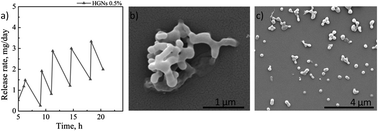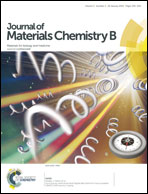Au–PLA nanocomposites for photothermally controlled drug delivery
Abstract
Stimuli-responsive drug delivery systems were obtained by encapsulating near-infrared (NIR) sensitive hollow gold nanoshells (HGNs) together with the molecule to be released into biodegradable poly-lactic acid (PLA) sub-micron particles. The rapid heating of the PLA particles caused by NIR radiation enabled use of the PLA–HGN composites as a photo-triggered drug release system. Rhodamine was used as a test molecule to obtain release profiles under different irradiation conditions. HGNs (32 nm diameter, 4.5 nm shell thickness) were synthesized via galvanic replacement of cobalt nanoparticles, using poly(vinylpyrrolidone) (PVP) as a stabilizer. PLA–HGN sub-micron particles (with mean diameters around 200 nm) encapsulating rhodamine were obtained using the supercritical emulsion extraction (SEE) technique. A good gold dispersion and a loading efficiency around 50% in the polymeric matrix were obtained for different HGN loadings. The release rate could be tuned by controlling the intensity of NIR exposition. Rhodamine release was completed in less than 10 hours when applying intense NIR irradiation for a few minutes, whereas 12 days of release was necessary in its absence. The system also allowed rhodamine release in a pulsed pattern.


 Please wait while we load your content...
Please wait while we load your content...